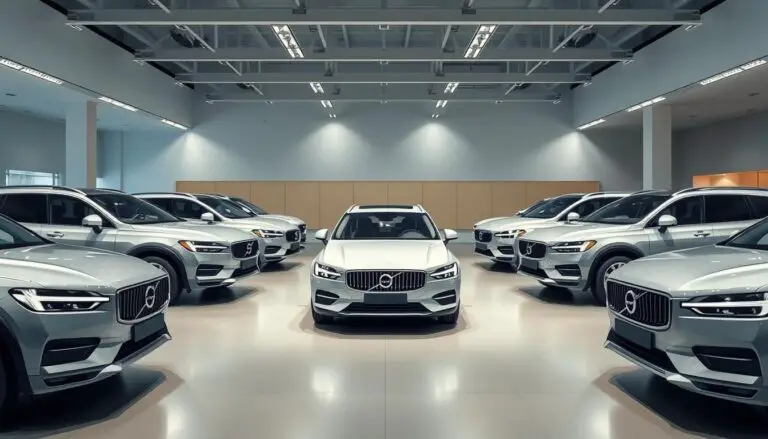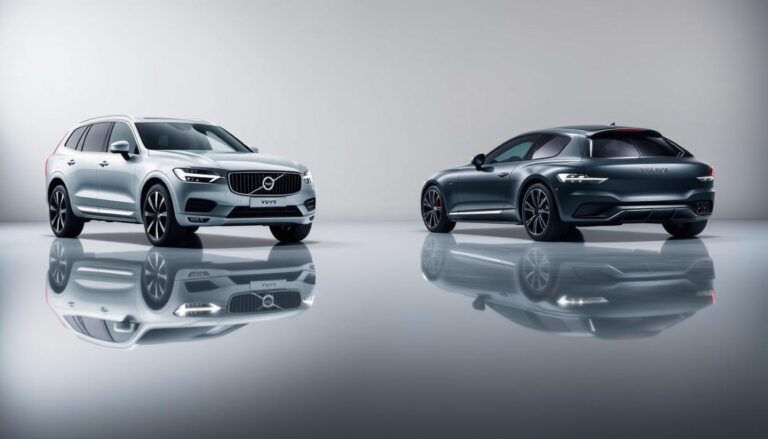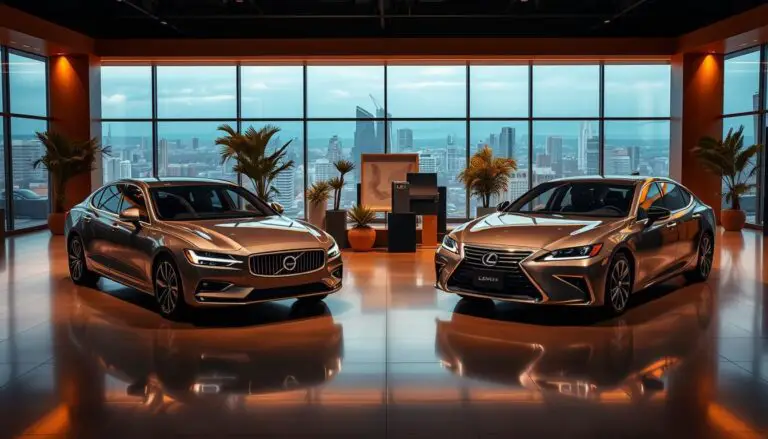The automotive market is filled with numerous brands, but few have managed to establish themselves as stalwarts like Volvo and Honda. Both manufacturers have a rich history and a loyal customer base, making a comparison between them a topic of great interest for potential car buyers.
This article aims to provide a comprehensive automotive review of these two brands, pitting them against each other in various aspects such as brand heritage, model lineups, and safety features. By examining their strengths and weaknesses, we can gain a deeper understanding of which brand comes out on top.
Key Takeaways
- Comparison of brand heritage and history
- Analysis of model lineups and their features
- Evaluation of safety features and ratings
- Assessment of performance and reliability
- Overview of pricing and value for money
Brand Heritage and Market Position
Volvo and Honda, two automotive giants, have rich histories that have significantly influenced their current market standings. Their brand heritages are deeply rooted in their founding principles and have evolved over the years to shape their market positions.
Volvo’s Swedish Legacy and Safety Focus
Volvo, founded in 1927 in Gothenburg, Sweden, is renowned for its emphasis on safety. The brand’s commitment to protecting its passengers has been a cornerstone of its identity. Volvo’s history is marked by numerous innovations in safety technology, including the introduction of the three-point seatbelt in 1959. This legacy continues to influence Volvo’s design and engineering decisions, with a focus on creating vehicles that are not only safe but also comfortable and environmentally friendly.
Honda’s Japanese Engineering Excellence
Honda, established in 1948 in Japan, has built a reputation for its engineering excellence and innovative approach to vehicle design. Known for its performance, reliability, and fuel efficiency, Honda has become a favorite among car enthusiasts worldwide. The brand’s commitment to research and development has led to significant advancements in automotive technology, including improvements in engine efficiency and the development of hybrid vehicles.
| Brand | Founding Year | Notable Innovation |
|---|---|---|
| Volvo | 1927 | Three-point seatbelt (1959) |
| Honda | 1948 | Hybrid Vehicle Technology |
Model Lineup Comparison
Volvo and Honda present distinct model lineups that reflect their brand identities and market strategies. This comparison highlights the diverse range of vehicles each brand offers, catering to different consumer needs.
Volvo’s Vehicle Categories
Volvo’s model lineup is characterized by its focus on luxury and safety. The brand offers a range of vehicles that can be broadly categorized into luxury sedans and wagons, as well as SUVs and crossover options.
Luxury Sedans and Wagons
Volvo’s luxury sedans, such as the S60 and S90, are known for their premium comfort and advanced safety features. The V60 and V90 wagons offer additional cargo space without compromising on luxury.
SUV and Crossover Options
Volvo’s SUV lineup includes the XC40, XC60, and XC90, offering a range of sizes and capabilities. These vehicles are designed to provide both urban agility and off-road capability.
Honda’s Vehicle Range
Honda’s model lineup is diverse, with a focus on practicality and performance. The brand offers compact and mid-size sedans, as well as SUVs, minivans, and trucks.
Compact and Mid-Size Sedans
Honda’s compact and mid-size sedans, including the Civic and Accord, are popular for their reliability and fuel efficiency.
SUVs, Minivans, and Trucks
Honda’s SUV lineup includes the CR-V and Pilot, while the Odyssey minivan is renowned for its family-friendly features. The Ridgeline truck offers versatility and capability.
Safety Features and Crash Test Ratings
Volvo and Honda are renowned for their commitment to vehicle safety, incorporating innovative technologies into their models. Both brands have a strong reputation for producing safe vehicles, backed by impressive crash test ratings.
Volvo’s Innovative Safety Technologies
Volvo has been a pioneer in automotive safety for decades. Their vehicles are equipped with a range of safety features designed to prevent accidents and protect occupants.
Active Safety Systems
Volvo’s active safety systems include features like automatic emergency braking and lane departure warning. These systems work together to help prevent accidents.
Passive Safety Features
In addition to active safety systems, Volvo vehicles are designed with passive safety features such as advanced airbag systems and reinforced body structures to protect occupants in the event of a collision.
Honda’s Safety Sensing Suite
Honda has also made significant advancements in safety technology with its Safety Sensing Suite. This suite includes a range of features designed to enhance safety on the road.
Collision Mitigation Systems
Honda’s collision mitigation systems can automatically apply the brakes to prevent or mitigate the severity of a collision. This feature is a key component of Honda’s safety offerings.
Driver Assistance Features
Honda’s driver assistance features, including adaptive cruise control and lane keeping assist, help reduce driver fatigue and enhance overall safety.
Both Volvo and Honda have received high safety ratings from reputable organizations such as the National Highway Traffic Safety Administration (NHTSA) and the Insurance Institute for Highway Safety (IIHS).
| Brand | NHTSA Rating | IIHS Rating |
|---|---|---|
| Volvo | 5-star overall safety rating | Top Safety Pick+ |
| Honda | 5-star overall safety rating | Top Safety Pick |
The safety features and crash test ratings of Volvo and Honda vehicles demonstrate their commitment to protecting drivers and passengers. By incorporating advanced safety technologies, both brands continue to set high standards in the automotive industry.
Performance and Driving Experience
Evaluating the performance and driving experience of Volvo and Honda reveals the engineering philosophies that drive these brands. Both manufacturers have a reputation for delivering high-quality vehicles, but their approaches to performance and handling differ significantly.
Volvo’s Engine Options and Handling
Volvo’s performance is characterized by its range of engine options, including turbocharged and hybrid powertrains. These engines not only provide a boost in power but also contribute to a more responsive driving experience.
Turbocharged and Hybrid Powertrains
Volvo’s turbocharged engines offer increased power and efficiency, making them a popular choice among drivers who value performance. The hybrid options, on the other hand, provide a balance between power and environmental sustainability.
Ride Quality and Driving Dynamics
The ride quality in Volvo vehicles is often described as comfortable and serene, thanks to their sophisticated suspension systems. Driving dynamics are also enhanced by their precise steering and responsive handling.
Honda’s Performance Specifications
Honda’s performance is rooted in its innovative engine technologies and handling capabilities. The brand is known for delivering vehicles that are both fun to drive and responsive to driver input.
VTEC Engine Technology
Honda’s VTEC engine technology is a hallmark of its performance-oriented approach. This technology allows for variable valve timing and lift, resulting in improved power output and efficiency.
Handling and Responsiveness
Honda vehicles are praised for their agile handling and responsiveness. The brand’s focus on creating a engaging driving experience is evident in its carefully tuned suspension and steering systems.
In conclusion, both Volvo and Honda offer compelling performance and driving experiences, each with its unique strengths. Whether it’s Volvo’s emphasis on comfort and safety or Honda’s focus on handling and responsiveness, drivers have a range of options to choose from based on their preferences.
Fuel Efficiency and Environmental Impact
In an era where environmental consciousness is on the rise, the fuel efficiency of cars has become a pivotal aspect of the purchasing decision. As consumers become more eco-aware, the automotive industry is responding with innovative solutions to reduce environmental impact.
Volvo’s Hybrid and Electric Options
Volvo has been at the forefront of electric vehicle technology, offering a range of hybrid and electric models. Their commitment to reducing emissions is evident in their Recharge lineup, which includes plug-in hybrids and fully electric vehicles. For instance, the Volvo XC90 Recharge offers impressive fuel efficiency without compromising on performance. You can explore more about Volvo’s competitors and their electric offerings in our comparison with Subaru.
Honda’s Fuel Economy Ratings
Honda is renowned for its fuel-efficient vehicles, with models like the Honda Civic and Honda Insight offering exceptional fuel economy ratings. Honda’s approach to improving fuel efficiency includes optimizing engine performance and reducing vehicle weight. According to the United States Environmental Protection Agency (EPA), Honda’s compact cars consistently rank high in fuel efficiency, making them a popular choice for eco-conscious drivers.
As the automotive landscape continues to evolve, both Volvo and Honda are making significant strides in reducing environmental impact. By offering hybrid, electric, and fuel-efficient models, these manufacturers are catering to the growing demand for sustainable transportation solutions.
Exterior Design and Aesthetics
When it comes to automotive design, Volvo and Honda have distinct approaches that set them apart in the market. The exterior design of a vehicle is a crucial element that not only influences its visual appeal but also reflects the brand’s design philosophy.
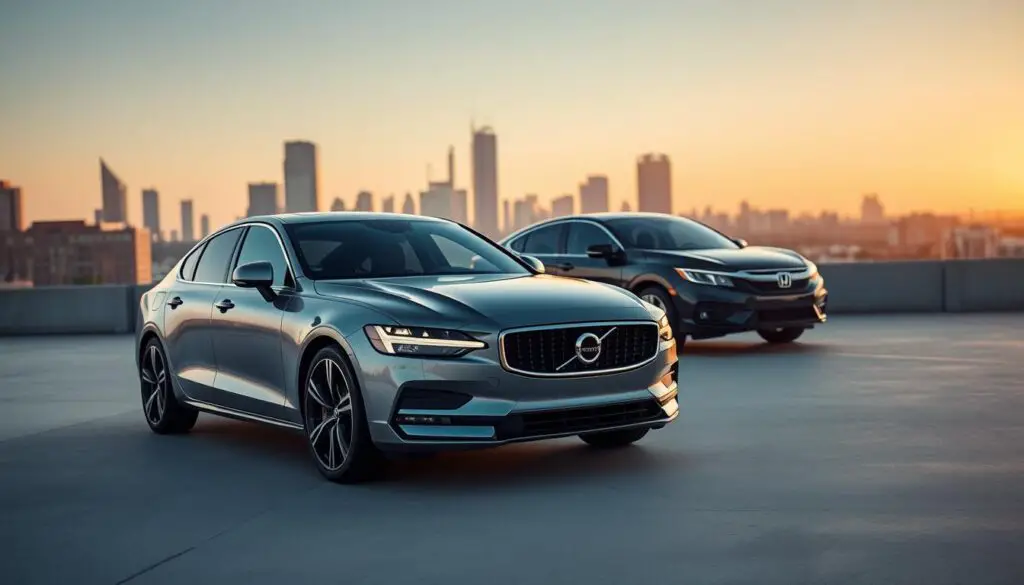
Volvo’s Minimalist Scandinavian Styling
Volvo’s design language is characterized by its minimalist Scandinavian styling, emphasizing simplicity, functionality, and a strong emphasis on safety. The brand’s vehicles are known for their clean lines, uncluttered surfaces, and a restrained use of ornamentation. As Thomas Ingenlath, Senior Vice President Design at Volvo Cars, once noted, “Design is not just about making something look good; it’s about creating a sense of purpose.” This philosophy is evident in models like the XC90, where the exterior design seamlessly integrates with the brand’s safety-focused identity.
Honda’s Practical yet Modern Design Language
Honda, on the other hand, adopts a practical yet modern design approach, balancing functionality with a keen eye for aesthetics. Honda’s vehicles often feature bold lines, a prominent front grille, and a dynamic overall stance. The brand’s design philosophy is centered around the concept of “Man Maximum, Machine Minimum,” aiming to create vehicles that are both functional and visually appealing. As Honda’s global design chief, Yuki Terai, has mentioned, the brand focuses on creating designs that are not only exciting but also enduring.
The contrast between Volvo’s understated elegance and Honda’s more assertive styling highlights the diversity in automotive design. While both brands have their unique strengths, their exterior designs cater to different consumer preferences, making the choice between them a matter of personal taste and priorities.
Interior Design and Comfort
The cabin experience is a crucial aspect of any vehicle, with Volvo and Honda offering contrasting yet compelling interior designs. This section delves into the intricacies of their interior design philosophies, focusing on comfort, ergonomics, and overall cabin experience.
Volvo’s Premium Cabin Experience
Volvo is renowned for its luxurious and minimalist interior design, emphasizing premium materials and exceptional build quality.
Materials and Build Quality
Volvo’s interiors are characterized by the use of high-quality materials, including rich leather upholstery, genuine wood trim, and soft-touch plastics. The attention to detail in their cabin design contributes to a sense of luxury and sophistication.
Seating Comfort and Space
Volvo vehicles are designed to provide ample legroom and comfort, even in the rear seats. The seats are ergonomically designed to support long drives, reducing fatigue.
Honda’s Practical and Ergonomic Approach
Honda, on the other hand, focuses on practicality and ergonomics in their interior design, ensuring that their vehicles are both comfortable and functional.
Cabin Layout and Versatility
Honda’s cabin layouts are designed to maximize space and versatility, with features like fold-down rear seats to increase cargo capacity. The controls are intuitively placed, enhancing the driving experience.
Passenger and Cargo Space
Honda vehicles are known for their spacious interiors, offering generous legroom and cargo space. This makes them ideal for family road trips or daily commutes.
To illustrate the differences and similarities between Volvo and Honda’s interior designs, consider the following comparison:
| Feature | Volvo | Honda |
|---|---|---|
| Material Quality | Premium leather, genuine wood | Durable plastics, available leather |
| Seating Comfort | Ergonomic design, ample legroom | Supportive seating, generous legroom |
| Cargo Space | Competitive cargo capacity | Spacious, with fold-down rear seats |
In conclusion, both Volvo and Honda offer compelling interior designs that cater to different needs and preferences. While Volvo excels in luxury and minimalist aesthetics, Honda prioritizes practicality and ergonomics.
Technology and Infotainment Systems
The technological advancements in modern vehicles have significantly enhanced the driving experience, with Volvo and Honda leading the charge in innovative infotainment systems.
Both brands have made significant strides in integrating technology into their vehicles, enhancing safety, convenience, and entertainment on the road.
Volvo’s Sensus Connect System
Volvo’s Sensus Connect system is a sophisticated infotainment platform that offers a seamless user experience. With a high-resolution touchscreen display, drivers can access a range of features, including navigation, media, and vehicle settings.
Key Features of Sensus Connect:
- Intuitive interface with voice control
- Smartphone integration via Apple CarPlay and Android Auto
- Real-time traffic updates and navigation
Honda’s Display Audio Interface
Honda’s Display Audio interface is designed to provide a user-friendly experience, with a focus on simplicity and functionality. The system features a touchscreen display and supports various connectivity options.
Key Features of Display Audio:
- Customizable home screen
- Compatibility with Apple CarPlay and Android Auto
- Multi-angle rearview camera
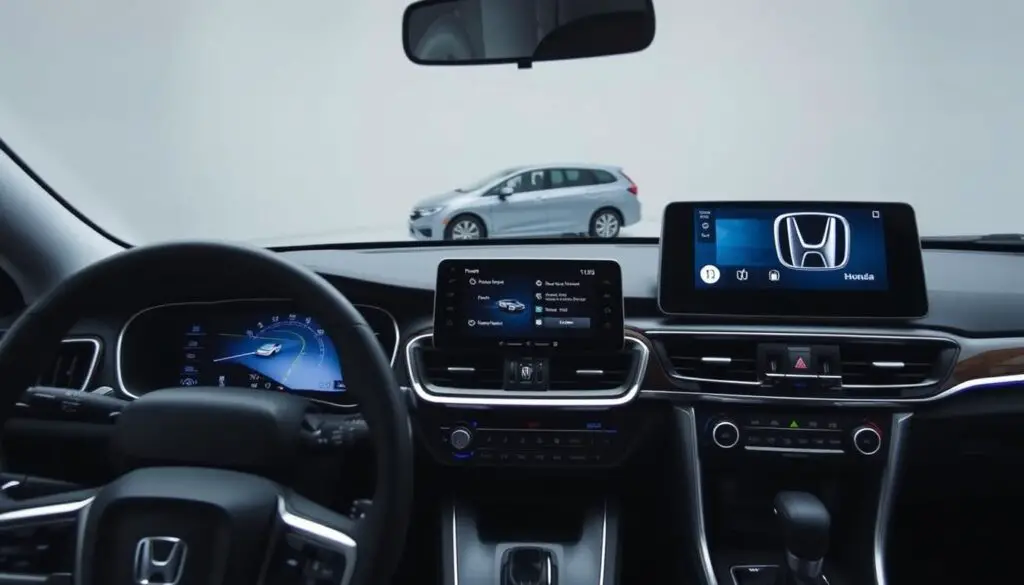
| Feature | Volvo Sensus Connect | Honda Display Audio |
|---|---|---|
| Touchscreen Display | Yes | Yes |
| Smartphone Integration | Apple CarPlay, Android Auto | Apple CarPlay, Android Auto |
| Navigation | Real-time traffic updates | Available with optional features |
Price Comparison: Volvo vs Honda
Understanding the total cost of ownership is crucial when deciding between Volvo and Honda. This includes both the initial purchase costs and the long-term ownership expenses.
Initial Purchase Costs
The initial purchase price is a significant factor in choosing between Volvo and Honda. According to data from manufacturer websites and automotive pricing guides, the sticker prices for Volvo models tend to be higher than those for Honda models.
Long-term Ownership Expenses
Long-term ownership expenses include maintenance, fuel, and insurance costs. A comparison of these costs reveals that Volvo’s expenses are generally higher due to its premium branding and advanced safety features.
| Cost Category | Volvo | Honda |
|---|---|---|
| Initial Purchase Price | $40,000 – $60,000 | $25,000 – $40,000 |
| Annual Maintenance Cost | $1,000 – $1,200 | $500 – $800 |
| Fuel Costs (Annual) | $1,500 – $2,000 | $1,000 – $1,500 |
| Insurance Costs (Annual) | $1,200 – $1,500 | $800 – $1,200 |
Reliability, Resale Value, and Maintenance
As automotive enthusiasts weigh their options between Volvo and Honda, reliability and resale value become key differentiators. Both brands have established reputations in these areas, influencing long-term ownership experiences.
Volvo and Honda are known for their commitment to quality, but their approaches to reliability and resale value differ. Understanding these differences is crucial for potential buyers.
Volvo’s Reliability Ratings and Warranty
Volvo has made significant strides in reliability, with many of its models receiving high ratings in reliability surveys. Volvo’s warranty program also provides comprehensive coverage, enhancing buyer confidence. The brand’s focus on safety and quality contributes to its reliability.
Honda’s Reputation for Dependability
Honda is renowned for its dependable vehicles, with a long history of producing cars that withstand the test of time. Honda’s reliability is reflected in its high ratings across various reliability and satisfaction surveys.
Comparative Resale Value Analysis
Resale value is a critical factor in the total cost of ownership. The following table compares the resale values of Volvo and Honda models after five years:
| Brand | Model | Original Price | Resale Value | Retention Percentage |
|---|---|---|---|---|
| Volvo | XC90 | $50,000 | $30,000 | 60% |
| Honda | Civic | $20,000 | $12,000 | 60% |
| Volvo | S60 | $40,000 | $24,000 | 60% |
| Honda | Accord | $25,000 | $15,000 | 60% |
Both Volvo and Honda demonstrate strong resale values, with certain models retaining up to 60% of their original price after five years. This analysis highlights the importance of considering resale value when choosing between these brands.
Conclusion: Which Brand Is Right for You?
Choosing between Volvo and Honda for your next vehicle can be a challenging decision, given the unique strengths of each brand. Throughout this comparison, we’ve examined various aspects, including brand heritage, safety features, performance, design, and cost.
Volvo stands out for its commitment to safety, Scandinavian design, and premium feel, making it an attractive option for those prioritizing these aspects. On the other hand, Honda is renowned for its reliability, fuel efficiency, and practicality, appealing to buyers seeking a dependable and cost-effective vehicle.
When making your car buying decision, consider what matters most to you in an automotive comparison. If luxury, advanced safety features, and a sophisticated driving experience are your priorities, Volvo may be the better choice. However, if you’re looking for a reliable, fuel-efficient vehicle with a lower total cost of ownership, Honda is worth considering.
Ultimately, the decision between Volvo and Honda depends on your individual needs and preferences. By weighing the pros and cons of each brand, you can make an informed decision that suits your lifestyle and driving habits.
FAQ
What are the main differences between Volvo and Honda?
Volvo is known for its luxury vehicles with a strong emphasis on safety, while Honda is recognized for its reliability and wide range of models, including compact sedans and SUVs.
Which brand offers better safety features?
Both Volvo and Honda prioritize safety, but Volvo is particularly renowned for its advanced safety technologies, including City Safety and Pilot Assist.
How do the fuel efficiency ratings compare between Volvo and Honda?
Honda generally offers more fuel-efficient options, especially in its compact sedan lineup, while Volvo’s hybrid and electric models provide competitive fuel economy ratings.
What are the key differences in their design philosophies?
Volvo is characterized by its minimalist Scandinavian styling, focusing on clean lines and simplicity, whereas Honda adopts a more practical yet modern design language, often incorporating bold styling cues.
How do their pricing and ownership costs compare?
Volvo tends to be pricier, reflecting its luxury positioning, while Honda is generally more affordable; however, long-term ownership costs, including maintenance and fuel, should be considered for a comprehensive comparison.
Which brand has a better resale value?
Honda is known for holding its value well, thanks to its reputation for reliability and durability, although Volvo’s luxury models can also retain a significant portion of their initial purchase price.
What are the main differences in their infotainment systems?
Volvo’s Sensus Connect system is praised for its intuitive interface and seamless connectivity, while Honda’s Display Audio interface offers a user-friendly experience with features like Apple CarPlay and Android Auto.
How do their reliability ratings compare?
Honda is consistently rated highly for reliability, while Volvo has made significant improvements in recent years, with both brands offering competitive warranty packages.

